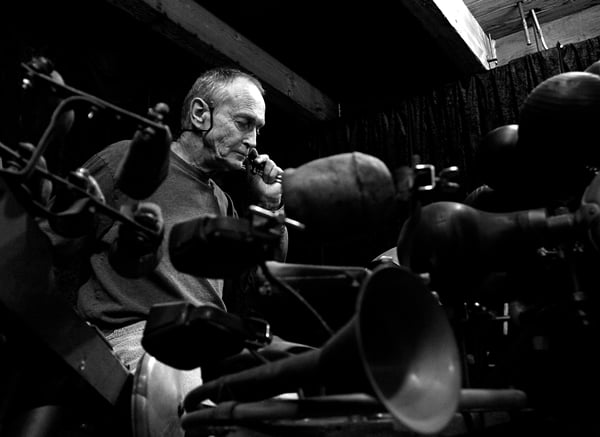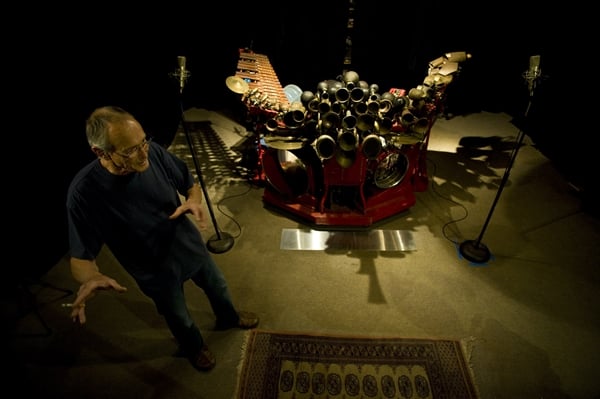Reviews
Llyn Foulkes Documentary at Film Forum
Does the new doc legitimize this outsider's late-career fame?

Does the new doc legitimize this outsider's late-career fame?

The documentary Llyn Foulkes One Man Band, which opened this week at New York’s Film Forum, follows the artist Llyn Foulkes from 2004 to 2011, during which time he ages from 70 to 79 and struggles to finish two major works. Psychologically blocked from relinquishing them, he maintains a humorous façade and is an entertaining tour guide to his world, but his melancholy is evident.
Foulkes’s curse is a boon for viewers interested in his process. The film captures him agonizing particularly over what changes to make to The Lost Frontier—a sardonic denunciation of the corporate despoliation of California—right up to the day before he submits it for exhibition in 2005. Mickey Mouse, long the symbolic target of Foulkes’s anti-capitalist anger, stands sentinel on the relief painting’s junk-strewn Hollywood Hills in pioneer-woman drag holding an assault rifle.
At one point, Foulkes finesses the painting with a hammer. Later he saws a chunk off The Awakening, a painting of Foulkes and his second wife in bed that lugubriously encapsulates the failure of their marriage.
The documentary was directed by Tamar Halpern (not the New York artist of that name) and Chris Quilty, who had previously made the 20-minute documentary Lynn Foulkes’s Lost Frontier. Halpern, who had gotten to know Foulkes as an LA neighbor, also cast him as a grandfather in her 2008 teen movie Your Name Here.

Llyn Foulkes.
Courtesy of Chris Quilty.
Neither Halpern (the film’s main interviewer) nor Quilty (its chief cinematographer) understands why Foulkes takes so long over his paintings. “Everyone’s trying to figure that out. He can’t believe it himself,” Quilty says. “He was brave to let himself be so vulnerable on camera.”
Foulkes became an LA art star at the beginning of his career. A contemporary of Ed Moses, Kenneth Price, and Ed Ruscha at the Chouinard Art Institute, he began showing at the Ferus Gallery in 1959. He held his first solo show there in 1961. However, his criticism of the Light and Space works of Chouinard teacher and fellow Ferus exhibitor Robert Irwin led to his ostracism from the gallery.
He remained successful, winning the Paris Biennale painting prize in 1967. He was acclaimed for his rock paintings and assemblages, but mystified many observers with his “Bloody Heads” series, begun in the early 1970s. At the start of the documentary, he is no longer in favor and despairs that he will not be rediscovered, but subsequent events prove him wrong.
It seems likely he unconsciously resists completing his paintings so as not to risk failure. Asked if she thinks Foulkes’s paintings of mutilated heads have a self-reflexive quality, Halpern demurs.
“I think instead of looking in, he was looking out when he did them, as with his political landscapes of the late 1960s,” she says. “A lot of those heads belong to politicians. He had woken up politically while serving with the army in Germany before beginning his art career. From being amazed by the beauty of the planet, he had come to realize the planet was being destroyed by real estate developers, corporations like Disney that implant concepts like ‘Be a good citizen’ in children’s minds while making tons of useless plastic toys, and anyone who engages in war or politics that hurt people or the landscape.”

Llyn Foulkes.
Courtesy of Chris Quilty.
Foulkes’s painting of Walt Disney shows Mickey breaking through his creator’s face. This is ironic given that Foulkes’s first wife, Kelly, was a daughter of Ward Kimball, one of Disney’s “Nine Old Men” animators. (Foulkes remained close to his ex-father-in-law until his death.)
The film’s title derives from both Foulkes’s outsider status—the result of his refusal to pander to collectors or play the corporate art game—and his sideline as a singer and instrumentalist inspired by the musical satirist Spike Jones. He even had a fleeting residence on Johnny Carson’s “Tonight Show.”
As Foulkes’s eyes have weakened, his salve has become the multi-horned instrument called “The Machine,” on which he accompanies himself on his self-penned songs of folk wisdom. This fungal-looking contraption suggests a retro version of the keyboard played by Dr. Durand-Durand in Barbarella.
Apparently distracted from making art by the acclaim that greeted last year’s extensive Hammer Museum retrospective, Foulkes is currently “edging towards painting again,” says Quilty, “while developing this really wild, jazzy improvisational stuff.”
Llyn Foulkes One Man Band continues at Film Forum through May 13. The less experimental songs Foulkes contributed to the movie have been released on the soundtrack CD, which is available at Film Forum.